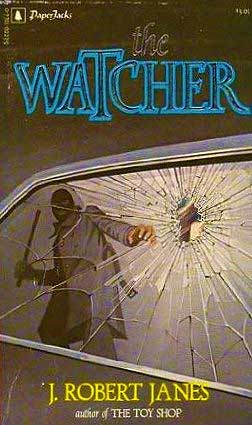 By J. ROBERT JANES (PaperJacks; 1982)
By J. ROBERT JANES (PaperJacks; 1982)
Yet another example of a book done in, commercially speaking, by poor packaging. This novel was written by Canada’s J. Robert Janes, who in recent years has become popular for his WWII-set St. Cyr and Kohler series, but in the early 1980s was known for writing horror paperbacks—see THE TOY SHOP (1981), THE THIRD STORY (1983) and THE HIDING PLACE (1984). THE WATCHER, a dense 400-plus page epic, is the most ambitious of the four books.
Yet another example of a book done in, commercially speaking, by poor packaging.
Indeed, it appears that with this book Janes was aiming for bestseller status, although his publisher, the Canadian paperback outfit PaperJacks, had less lofty goals. The packaging is quite trashy, with cover art that errs on the lurid side and a misleading tagline promising “An hypnotic tale with the awful terror of PSYCHO and the intimate secrets of PEYTON PLACE.” The PSYCHO comparison is gratuitous, but the PEYTON PLACE one has some merit, as intimate secrets are something this book has in abundance—some might even say overabundance.
The title character is Nora, a child-woman severely traumatized by past events who’s looked after by her mean-spirited aunt Ida. Nora, being a “watcher,” seems to know all the secrets of a lakeside Niagara-area town–all, that is, but one. The secret in question involves Collin McPhee, a childhood resident of the town who’s returned after being away for a couple decades in order to man a lighthouse. His true reason for returning is to investigate the death of his mother, which occurred on the lake years earlier.

J Robert Janes
Another important player in this drama is Katie, a young woman who’s in town to film a documentary. She’s attacked one night in her jeep by an unseen someone who manhandles her and steals her pearls, which becomes the inception of a reign of violence and intimidation that sweeps the town. The residents, a colorful assortment of rednecks and psychopaths, are resentful of McPhee and Katie’s intrusion into their hermetic universe, which encompasses murder (more than one, as it turns out), a buried treasure and the revelation that two pivotal characters are more closely related than anyone thought. As to the identity of Katie’s nighttime attacker, it’s saved until the end.
…well imagined, but, unfortunately, not especially well written
All this is well imagined, but, unfortunately, not especially well written. Jaynes was a novelist that (back in the eighties) appeared to prize speed over effectiveness, resulting in prose that’s often cluttered and incoherent. This is an especially pressing problem given that there are so many characters to juggle, and just as many complicated backstories. A good editor might have spiffed things up, but PaperJacks wasn’t exactly known for its editorial prowess, resulting in a novel that strives for greatness but trips itself up rather severely.
